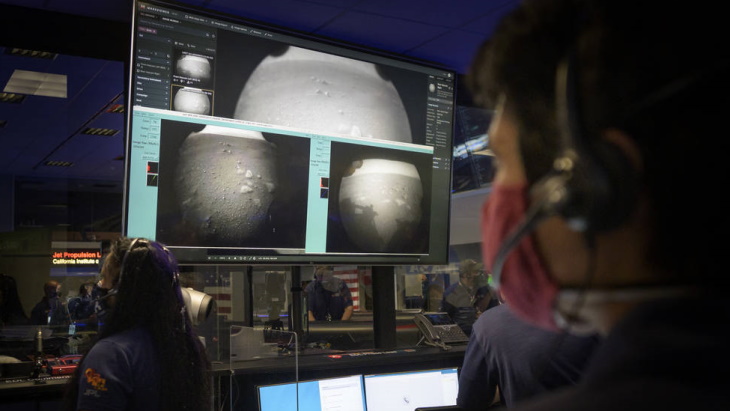Perseverance starts exploration of Mars
NASA's Perseverance rover successfully touched down on Mars yesterday, 203 days after being launched from Cape Canaveral in Florida. The rover, which is powered by a Multi-Mission Radioisotope Thermoelectric Generator (MMRTG) developed and fuelled in partnership with the US Department of Energy (DOE), will explore the Jezero Crater and collect samples that will eventually be returned to Earth.

Members of NASA's Perseverance Mars rover team watch in mission control as the first images arrive moments after the spacecraft successfully touched down on Mars (Image: NASA)
The successful touchdown was announced in mission control at NASA's Jet Propulsion Laboratory in Southern California at 3:55pm EST. The rover - described by NASA as a "robotic geologist and astrobiologist" - will undergo several weeks of testing before it begins its two-year science investigation of the crater, where it will investigate the rock and sediment of the ancient lakebed and river delta to characterise the region's geology and past climate. The Mars Sample Return campaign, which is being planned by NASA and ESA (the European Space Agency), aims to return samples collected by Perseverance to Earth where they will be studied for definitive signs of past life.
"This landing is one of those pivotal moments for NASA, the United States, and space exploration globally - when we know we are on the cusp of discovery and sharpening our pencils, so to speak, to rewrite the textbooks," acting NASA Administrator Steve Jurczyk said. The Mars 2020 Perseverance mission "personifies the human ideal of persevering toward the future and will help us prepare for human exploration of the Red Planet," he added.
"Perseverance is the first step in bringing back rock and regolith from Mars. We don't know what these pristine samples from Mars will tell us. But what they could tell us is monumental - including that life might have once existed beyond Earth," said Thomas Zurbuchen, associate administrator for science at NASA.
"It is so exciting seeing Perseverance, powered by a radioisotope thermoelectric generator successfully land on Mars today! This is just one more example of the many ways in which nuclear science and technology contributes to the advancement of humankind," World Nuclear Association Director General Sama Bilbao y Léon said.
Increasing Pu-238 capacity
The MMRTG providing Persevance with electricity and heat was provided to NASA through an ongoing partnership with the DOE to develop power systems for civil space applications. The radioisotope power system was developed at Idaho National Laboratory (INL) and converts heat from the decay of plutonium-238 (Pu-238) fuel - supplied by Oak Ridge National Laboratory - into electrical power. It has an operational lifespan of 14 years.
Pu-238 is made by irradiating neptunium-237, recovered from research reactor fuel or special targets, in research reactors but the USA lost its domestic capacity to produce the material in the late 1980s after the closure of reactors at Savannah River. The DOE, with NASA, in 2015 re-established production ORNL's High Flux Isotope Reactor (HFIR), which has now produced 1 kg of the heat-source material.
The DOE this week said it is working to scale up its production of Pu-238 to support NASA's goal of producing 1.5 kilograms per year by of the material by 2026. A second assembly of seven targets of neptunium oxide and an aluminium metal powder has now been loaded into INL's Advanced Test Reactor (ATR), where it will be irradiated for 55 to 58 days, the DOE said. The irradiated targets will then be sent to ORNL to extract the plutonium and confirm the quality and quantity of the heat source material produced. INL expects to generate around 30 grams of Pu-238 heat source material from its first two campaigns. Seven targets were initially loaded into ATR in July 2019.
"While the United States has enough fuel to support space missions through the next decade, this continued partnership between the DOE and NASA ensures that there will be an ample supply of domestic plutonium to support future missions," the DOE said.
Next steps
Earlier this week, INL management and operating contractor Battelle Energy Alliance LLC announced it is partnering with NASA and the DOE to seek industry engagement to further the design of a new power system it says will be the "next step" for space exploration.
The Dynamic Radioisotope Power System (RPS) will use Pu-238 as a heat source and will be designed for a potential lunar demonstration mission by the late 2020s. The technology demonstration project aims to develop and demonstrate performance of a system that is three times more efficient than the current RPS technology. Dynamic power conversion is more efficient than thermoelectric conversion used in current systems such as that in the Perseverance rover, INL said. This will allow a Dynamic RPS to produce the same amount of electric power with less plutonium-238, and extend radioisotope power to larger systems.
Over the next seven years, the project will progress through additional phases to fabricate and qualify a Dynamic RPS for future science exploration missions, which could include small lunar experiments, rovers or small spacecraft, INL said.
Researched and written by World Nuclear News
- China Institute of Atomic Energy
- Nuclear Power Institute of China
- Southwestern Institute of Physics
- China Nuclear Power Operation Technology Corporation, Ltd.
- China Nuclear Power Engineering Co., Ltd.
- China Institute for Radiation Protection
- Beijing Research Institute of Uranium Geology (BRIUG)
- China Institute of Nuclear Industry Strategy (CINIS)
- China Nuclear Mining Science and Technology Corporation


